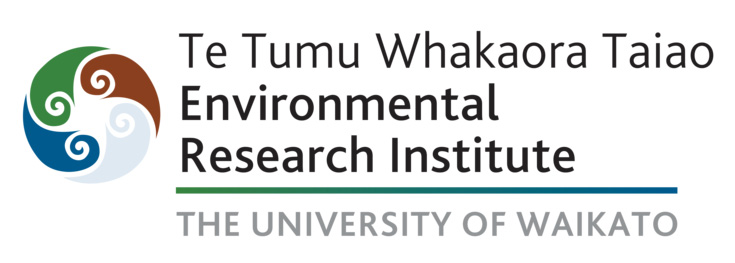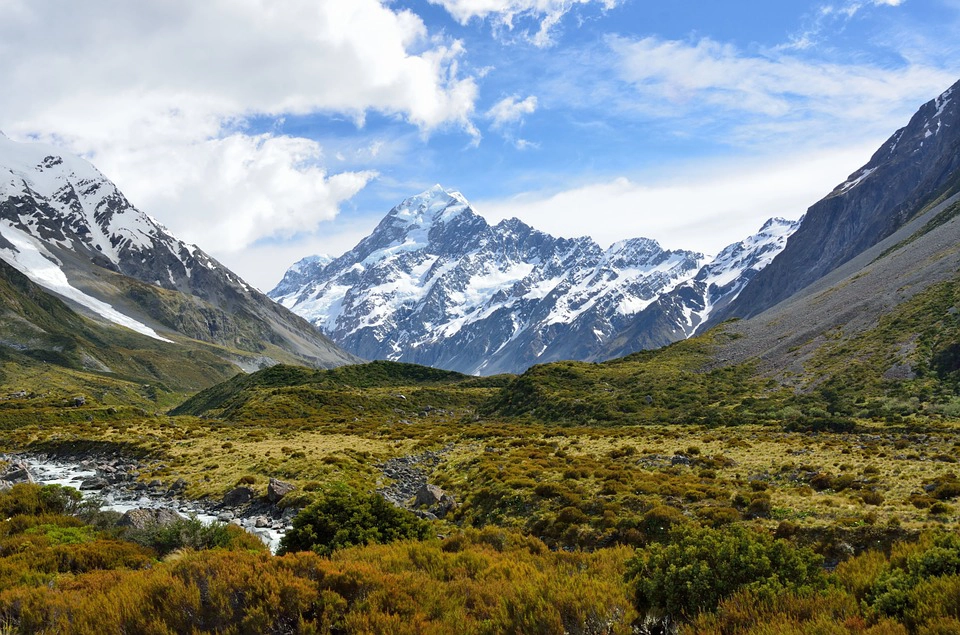
Anthropogenic effects on our environment have increased exponentially over the last 50 years. Now we face levels of carbon dioxide in our atmosphere that have not occurred in the last million years. As a consequence, our sealevel and atmospheric temperatures are rising. We have also increased nitrogen and phosphate loading to our soils in order to sustain our economy and food supply. Nitrogen and phosphate have run-off the land into our lakes, rivers and coastal ocean, and where they have caused algal blooms, reduced oxygen and toxic algae in many locations around the world. Managing these problems requires innovative research into interconnected terrestrial, marine and freshwater systems. Here we present some highlights from our activities over the last few years.
Native seaweed farming in Hauraki Gulf and Bay of Plenty
Contact: Dr. Marie Magnusson and Dr. Rebecca Lawton

UoW PhD student Jacob Nepper-Davidsen, Dave Blyth (Premium Seas Ltd) and Rebecca Lawton (UoW) with seaweed grow rope ready for outplanting (M. Magnusson)
Seaweed is a huge multi-billion dollar industry in Asia, but the potential of seaweed is yet to be fully explored and maximised in New Zealand. In partnership with iwi and local farmers, this pilot project is focused on creating a viable community model from seed to sale. It aims to develop and support the establishment of seaweed farms throughout New Zealand, using a regenerative ocean farming model developed in the United States. In addition to developing aquaculture protocols for the native kelp Ecklonia radiata, this project also hopes to quantify improvements in water quality from seaweed farming.
Quantifying past rainfall and climate extremes in New Zealand
Contact: Dr Adam Hartland
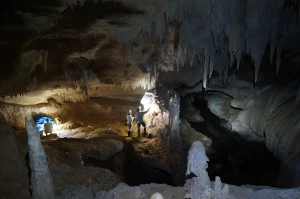 Most studies addressing the changing climate focus on average temperature variations. However, the extent to which climate change alters local short-term rainfall patterns, including extreme weather events, is equally important for New Zealanders. Unfortunately, environmental archives and proxies of this information are underdeveloped and underexploited, limiting our understanding of natural rainfall variability and complicating predictions of inevitable future changes in rainfall. Regional differences in atmospheric circulation due to New Zealand’s mountainous landscape compound this problem, meaning that long, quantitative records from different geographical settings are needed to quantify the regionally-complex patterns and trends, and validate models used for future climate prediction.
Most studies addressing the changing climate focus on average temperature variations. However, the extent to which climate change alters local short-term rainfall patterns, including extreme weather events, is equally important for New Zealanders. Unfortunately, environmental archives and proxies of this information are underdeveloped and underexploited, limiting our understanding of natural rainfall variability and complicating predictions of inevitable future changes in rainfall. Regional differences in atmospheric circulation due to New Zealand’s mountainous landscape compound this problem, meaning that long, quantitative records from different geographical settings are needed to quantify the regionally-complex patterns and trends, and validate models used for future climate prediction.
Unlocking the karst record: quantitative proxies of past climates from speleothems (Rutherford Discovery)
Contact: Dr Adam Hartland
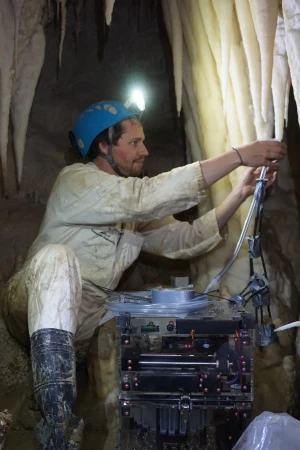 To understand ongoing climate change, the reconstruction of ancient environmental conditions and change is vital. Speleothems are cave carbonate deposits that provide excellent records of past environmental conditions. Recent technological advances haveprovided new quantitative tracers and analytical tools that can convert speleothem records into ancient rainfall and temperature recordings which are key climate indicators. Adam is developing new chemical and physical environmental proxies to study the changes in these ancient rainfall and temperature measurements, which will provide insight into the currentand future state of world climate.
To understand ongoing climate change, the reconstruction of ancient environmental conditions and change is vital. Speleothems are cave carbonate deposits that provide excellent records of past environmental conditions. Recent technological advances haveprovided new quantitative tracers and analytical tools that can convert speleothem records into ancient rainfall and temperature recordings which are key climate indicators. Adam is developing new chemical and physical environmental proxies to study the changes in these ancient rainfall and temperature measurements, which will provide insight into the currentand future state of world climate.
Human impacts in Antarctica
Contact: Dr Tanya O’Niell
New Zealand is a signatory to the Antarctica Treaty and Madrid Protocol, meaning our country has a role in safeguarding the Antarctic environment. Antarctic tourism, field-based research, National Antarctic Programmes, stations, and access is forecasted to increase in the coming years, so it is a matter of priority to advance our understanding of how sensitive sites will respond and recover from the impacts of visitation. Ice-free terrestrial areas constitute 0.18% of Antarctica, but represent the most biologically active and environmentally sensitive sites. Tanya’s main research focus is understanding the impacts of human activities on Antarctic terrestrial environments and quantifying the rates of landscape recovery following these human impacts.
Enzymes and temperature in soil
Contact: Professor Vic Arcus
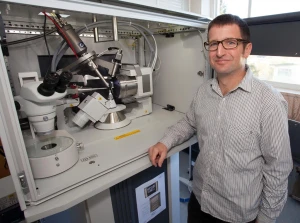 Enzymes are extraordinary catalysts that enable life to occupy nearly every available niche on our planet. These large, yet delicate, molecules show unusual responses to changes in temperature, which has a significant impact on how biological systems respond to temperature change. Vic and his team have developed a theoretical framework, Macromolecular Rate Theory (MMRT), which explains the catalytic behaviour of enzymes at different temperatures. Trends in the temperature dependence of biological rates at increasing levels of complexity (e.g. soil respiration and photosynthesis) can be quantified using MMRT.
Enzymes are extraordinary catalysts that enable life to occupy nearly every available niche on our planet. These large, yet delicate, molecules show unusual responses to changes in temperature, which has a significant impact on how biological systems respond to temperature change. Vic and his team have developed a theoretical framework, Macromolecular Rate Theory (MMRT), which explains the catalytic behaviour of enzymes at different temperatures. Trends in the temperature dependence of biological rates at increasing levels of complexity (e.g. soil respiration and photosynthesis) can be quantified using MMRT.
From this research it has been hypothesised that the signature of enzyme MMRT can be found in complex processes such as microbial growth rates, plant and soil respiration, photosynthesis and, ultimately, landscape carbon sequestration. This research may pave an underlying understanding for predicting the behaviour of biological systems and their response to increasing atmospheric greenhouse gases and climate warming.
Tipping-point responses of coastal primary productivity to projected ocean acidification scenarios
Contact: Professor Conrad Pilditch, Professor Craig Cary, Dr Charles Lee
The global effects of elevated atmospheric CO2 is a prominent concern as it is driving ocean acidification, which negatively affects coral communities and shellfish aquaculture. Although microbial communities conduct the vital role of regenerating nutrients that sustains oceanic food webs, their response to ocean acidification is not understood. Changes in coastal microbial functionality due to ocean acidification has the potential to significantly affect primary production and communities which rely on this, such as wild fisheries, aquaculture, and tangata whenua. This research will show how microbial communities will respond to ocean acidification, which can provide insights into future coastal ocean responses to elevated CO2. This knowledge will infer ocean acidification limits for sustainable coastal resource management.
International collaboration on peat
Contact: Associate Professor Dave Campbell
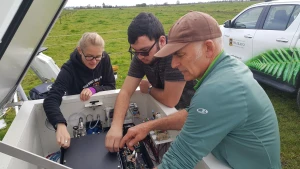 Peat soils make up a small percentage of New Zealand soils, but a disproportionately large contribution to soil carbon dioxide emissions. For every hectare, seven tonnes of carbon dioxide is produced per year. Peat soils are usually found in colder regions, but New Zealand’s farmed peat soils are in much warmer areas so can provide vital information on how greenhouse gas emissions (particularly methane, carbon dioxide, and nitrous oxide) may change in a warming climate.
Peat soils make up a small percentage of New Zealand soils, but a disproportionately large contribution to soil carbon dioxide emissions. For every hectare, seven tonnes of carbon dioxide is produced per year. Peat soils are usually found in colder regions, but New Zealand’s farmed peat soils are in much warmer areas so can provide vital information on how greenhouse gas emissions (particularly methane, carbon dioxide, and nitrous oxide) may change in a warming climate.
David and his team have been working on PEATWISE, a 3-year research collaboration with researchers from Norway, Sweden, Finland, Denmark, Netherlands, and Germany. The project aims to determine the best farm management of drained peatlands to minimise greenhouse gas emissions while still maintaining biomass production.
An isotopic toolkit for cadmium management: from agrisystems to ecosystems
Contact: Dr Adam Hartland
Cadmium is a biotoxic element that is present in fertilisers used extensively in New Zealand agriculture. It is a heavy metal which bioaccumulates in algae, plants, and vertebrates, causing adverse health issues. Adam will be investigating the fate of cadmium in soils, water, and cropping plants. The transfer of cadmium from soil to groundwater of natural ecosystems will be studied, as well as how to minimise the movement of cadmium. A new tool will be developed to allow Regional Councils and farmers to manage cadmium loads in the most practical and sensitive way.
Flushing times and water quality in the Maketu Estuary due to river diversion
Contact: Dr Shari Gallop
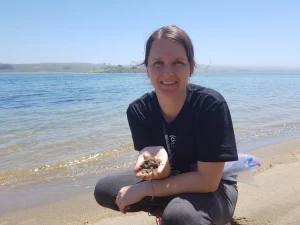 Estuaries provide a wealth of ecosystem services but a number of estuarine species have declined throughout New Zealand and globally due to increasing anthropogenic pressure. Some of the most problematic estuaries are located in the Bay of Plenty (BOP) and suffer from excess nutrients, poor water quality and sedimentation issues.
Estuaries provide a wealth of ecosystem services but a number of estuarine species have declined throughout New Zealand and globally due to increasing anthropogenic pressure. Some of the most problematic estuaries are located in the Bay of Plenty (BOP) and suffer from excess nutrients, poor water quality and sedimentation issues.
Shari is working in the Maketū estuary in the BOP where the BOP Regional Council are rediverting the Kaituna river to return the mana, flow and kaimoana to the estuary. This project aims to understand how water quality and tidal flushing in the estuary affects water quality and sedimentation, which relates to the ecosystem functioning. The rediversion offers a unique opportunity to understand the impacts of estuarine hydrodynamics on estuarine health, which is of high significance to the community and iwi who have continually fought for this.
Increasing carbon content of pasture soils
Contact: Professor Louis Schipper
 Pastoral agriculture is the dominant land use in New Zealand and sustains some of our key export industries. Ongoing research by Louis has demonstrated that some New Zealand soils have had long-term losses of carbon due to grazing. There is an opportunity to increase soil carbon content by altering management practices, but it is important that these practices don’t decrease grass growth or farm production. This project is investigating ways to increase soil carbon content by increasing root inputs from a more diverse pasture blend. Results could lead to a greater understanding of how farm management practices and carbon storage are able to work hand in hand.
Pastoral agriculture is the dominant land use in New Zealand and sustains some of our key export industries. Ongoing research by Louis has demonstrated that some New Zealand soils have had long-term losses of carbon due to grazing. There is an opportunity to increase soil carbon content by altering management practices, but it is important that these practices don’t decrease grass growth or farm production. This project is investigating ways to increase soil carbon content by increasing root inputs from a more diverse pasture blend. Results could lead to a greater understanding of how farm management practices and carbon storage are able to work hand in hand.
